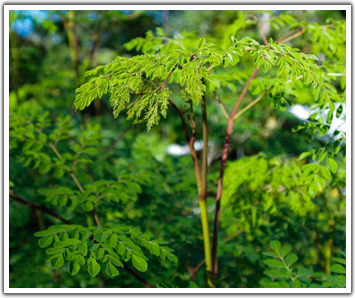Moringa oleifera Lam. is a medium-sized tree with a straight trunk with bark that is whitish grey. It has a tuberous taproot that can tolerate drought conditions. This umbrella shaped tree has a loose crown of feathery foliage. The foliage is evergreen or deciduous depending on environmental conditions. In season the trees are covered in creamy white flowers arranged in drooping panicles. Moringa leaves are an inexpensive source of proteins, vitamins and minerals. Seeds of Moringa oleifera yield 25 - 30% non-drying oil, known as Ben oil, used for lighting and lubrication of watches and other delicate machinery. The oil is clear, sweet, odourless and turns rancid slowly. This oil resembles olive oil and may be of value as a constituent of non-yellowing, non-drying plasticising alkyds and is highly valued by perfumers. |
 | The main uses of Moringa can be summarized as:  Oil for human consumption and Bio-fuel Oil for human consumption and Bio-fuel Leaf powder for human and animal consumption Leaf powder for human and animal consumption Press cake and animal fodder Press cake and animal fodderThe development of Moringa plantations to improve socio-economic conditions of rural communities are supported by various NGO's, Trees for life, Church World Service and Hunger organisations. At "The Moringa Tree" the vision of the team is to develop sustainable production systems for Moringa, that can be implemented in Africa for long term financial gain, job creation and poverty alleviation in rural areas. The team favours an integrated farming system with the production of both primary and secondary moringa products and by thus reducing risk to the minimum and optimizing the potential for long term success of moringa projects. |
WELCOME TO OUR WEBSITE
Moringa oleifera Lam. is a medium-sized tree with a straight trunk with bark that is whitish grey. It has a tuberous taproot that can tolerate drought conditions. This umbrella shaped tree has a loose crown of feathery foliage. The foliage is evergreen or deciduous depending on environmental conditions. In season the trees are covered in creamy white flowers arranged in drooping panicles.
Moringa leaves are an inexpensive source of proteins, vitamins and minerals. Seeds of Moringa oleifera yield 25 - 30% non-drying oil, known as Ben oil, used for lighting and lubrication of watches and other delicate machinery. The oil is clear, sweet, odourless and turns rancid slowly. This oil resembles olive oil and may be of value as a constituent of non-yellowing, non-drying plasticising alkyds and is highly valued by perfumers.

The main uses of Moringa can be summarized as:
 Oil for human consumption and Bio-fuel
Oil for human consumption and Bio-fuel Leaf powder for human and animal consumption
Leaf powder for human and animal consumption Press cake and animal fodder
Press cake and animal fodderIn Africa a multi-purpose crop, such as Moringa will benefit rural communities in the sense that large scale plantations will provide substantive real employment opportunities and sustainable income for marginalised communities. Moringa is a suitable candidate for commercial establishment in different areas in Africa, as it, despite mostly naturally occurring in the tropics and sub-tropics, can tolerate higher temperature extremes and/or survive light frost and tolerates a wide range of soil and rainfall conditions.
The development of Moringa plantations to improve socio-economic conditions of rural communities are supported by various NGO's, Trees for life, Church World Service and Hunger organisations.
At "The Moringa Tree" the vision of the team is to develop sustainable production systems for Moringa, that can be implemented in Africa for long term financial gain, job creation and poverty alleviation in rural areas. The team favours an integrated farming system with the production of both primary and secondary moringa products and by thus reducing risk to the minimum and optimizing the potential for long term success of moringa projects.
